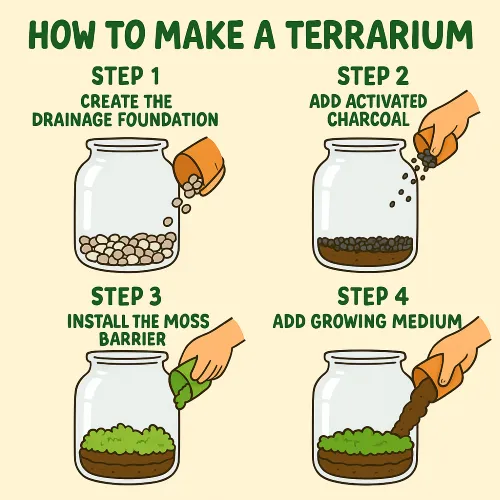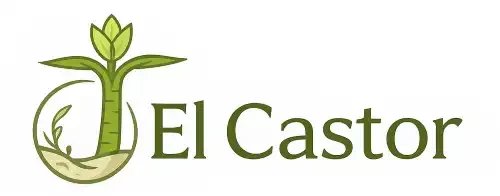Many people wonder how to make a terrarium when they see these enchanting glass worlds thriving with minimal care. The appeal stems from our innate desire to bring nature indoors while maintaining busy lifestyles that leave little time for extensive plant care.
Terrariums offer a perfect solution—self-contained ecosystems that mirror the natural water cycle, creating humid microclimates where delicate tropical plants can flourish. These miniature gardens have captivated plant enthusiasts since Dr. Nathaniel Ward accidentally discovered the concept in the 1830s, proving that plants could thrive in sealed glass environments.
Our question of June is: Is labradorite safe to use in damp terrariums?
How to make a terrarium?
Creating a terrarium involves layering drainage materials, soil, and carefully selected plants in a clear glass container to form a self-sustaining mini ecosystem. The process requires attention to proper layering techniques, plant selection, and understanding the delicate balance between moisture, light, and airflow.
Choosing your container
The foundation of any successful terrarium begins with selecting the right vessel. Clear containers with large enough openings to arrange plants are essential, and smooth, clear glass works best since colored glass blocks sunlight plants need to thrive.
Popular container options include:
- Large mason jars – Accessible and budget-friendly
- Aquarium tanks – Provide ample space for plant growth
- Goldfish bowls – Classic choice with wide openings
- Glass kitchen canisters – Modern, readily available option
- Vintage glass vessels – Unique character from thrift stores
The wider the opening, the easier your planting process will be. Avoid narrow-necked bottles for your first terrarium—save those for when you’ve mastered the basics with chopsticks and patience.
Essential materials and tools
Gather these materials before beginning:
Drainage Layer:
- Small pebbles, gravel, or LECA (Lightweight Expanded Clay Aggregate)
- Activated charcoal to prevent fungi and control odors
Growing Medium:
- Sterile potting soil without fertilizer
- Sheet moss or live sphagnum moss for separation
Tools:
- Long spoon or small trowel
- Spray bottle for watering
- Long tweezers or chopsticks for plant placement
- Small scissors for trimming
How to make a terrarium: Step-by-step
To help you know how to make a terrarium better, I make a simple infographic:

Step 1: Create the drainage foundation
Start with a 2-inch layer of gravel or small stones at the bottom. This prevents water from pooling around plant roots, which causes root rot in closed systems. For deeper containers, increase this layer proportionally.
Step 2: Add activated charcoal
Add a quarter- to half-inch layer of activated charcoal on top of the gravel to prevent fungi from growing when stones get wet. This acts as a natural filter, keeping your terrarium’s environment fresh and preventing unpleasant odors.
Step 3: Install the moss barrier
Place a layer of sheet moss over the charcoal and stones. This prevents the next layer of potting soil from mixing in and adds visual interest. Live moss can substitute for dried moss while providing additional odor control and vibrant color.
Step 4: Add growing medium
Add slightly damp, sterile potting soil on top of the moss using a soilless potting mix without fertilizer. Create enough depth for your plants’ root systems—typically 2-4 inches depending on your container size and plant selection.
Selecting the perfect plants
Plant selection determines your terrarium’s success more than any other factor. For closed terrariums, you need exclusively tropical plants that match the high humidity and temperature found in sealed environments.
Excellent beginner options:
Feature plants:
- Fittonia (Nerve Plant) – known for striking, contrasting venation and vibrant colors, perfect for beginners
- Peperomia varieties including ‘String of Turtles’ and ‘Mini Rubber Plant’
- Polka Dot Plant (Hypoestes) – loves warm, moist environments
Texture and ground cover:
- Various moss types including Sheet Moss and Cushion Moss
- Creeping fig with fresh green, heart-shaped leaves for ground cover
- Small ferns like Button Fern or Korean Rock Fern
Critical plant selection rules:
- Never mix tropical plants with succulents or cacti in closed terrariums
- Choose slow-growing, compact varieties
- Select plants with similar light and moisture requirements
- Avoid fertilized plants—the contained environment doesn’t need extra nutrients
Planting techniques
Preparing Your Plants:
Before planting, trim longer roots and remove yellowed or damaged leaves. Root pruning slows growth, essential for confined terrarium spaces.
Planting Process:
Arrange plants while still in their pots to visualize your design. Start with larger feature plants, then add smaller accent plants. Dig planting holes with a long spoon, place each plant, and gently pat soil to eliminate air pockets.
For narrow openings, use chopsticks or long tweezers for precise placement. Leave adequate space between plants—overcrowding leads to poor airflow and plant competition.
Watering and initial setup
The worst thing you can do is overwater terrarium plants. Use a mister rather than pouring water directly onto soil, and only water lightly when soil appears dry.
Initial watering should create slight moisture throughout the soil without creating soggy conditions. Check humidity levels by observing condensation—fogged glass during hot parts of the day indicates proper moisture levels.
Placement and ongoing care
Lighting Requirements:
Place terrariums in filtered light away from harsh direct sunlight. Glass can magnify sun rays and burn plants, while temperatures inside can rise quickly. North-facing windows provide ideal consistent indirect light.
Maintenance Schedule:
Weekly: Remove dead or yellowing plant material, check for mold, and assess moisture levels through condensation patterns.
Monthly: Clean glass with paper towels moistened with water, trimming overgrown plants as needed.
As Needed: If plants become leggy and overgrown, prune to maintain visibility of individual plants and decorative elements.
Conclusion
Last weekend, I guided my neighbor through creating her first terrarium using a vintage apothecary jar she’d inherited from her grandmother. Watching her carefully layer the drainage materials and select the perfect combination of emerald-green Fittonia and delicate button ferns reminded me why I fell in love with these miniature ecosystems. The terrarium now sits proudly on her kitchen windowsill, already showing the first signs of settling into its self-sustaining rhythm. This article represents years of experimenting with countless terrarium builds, learning from both spectacular successes and humbling failures in my quest to perfect these captivating glass gardens.
El Castor is your exclusive terrarium guide.
